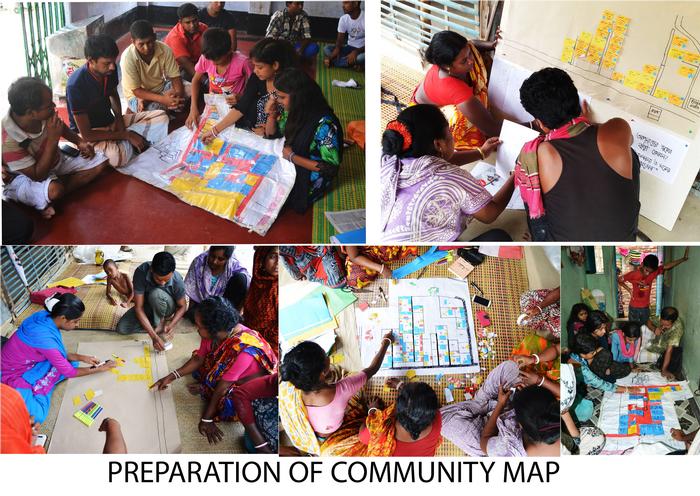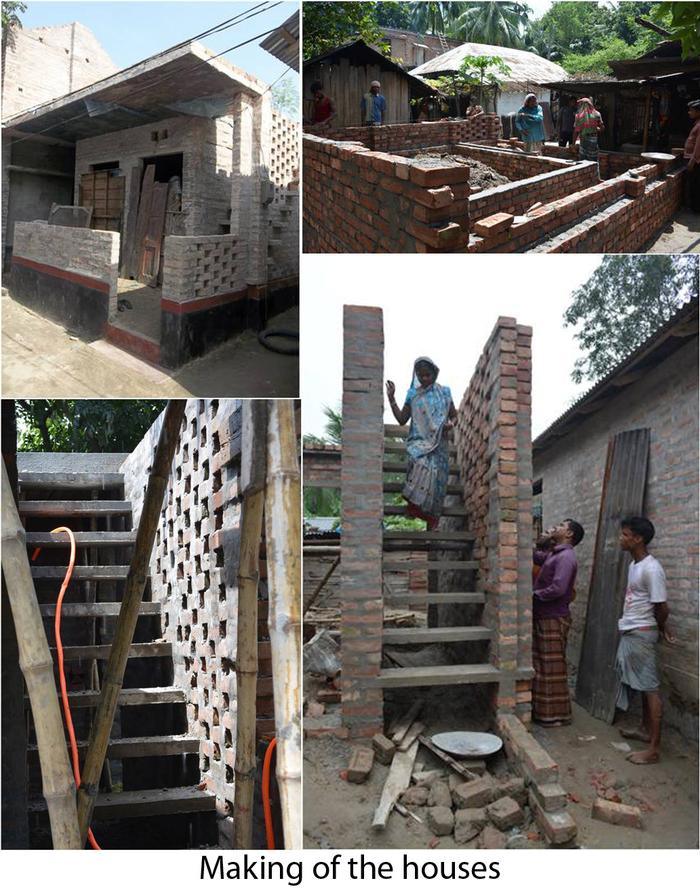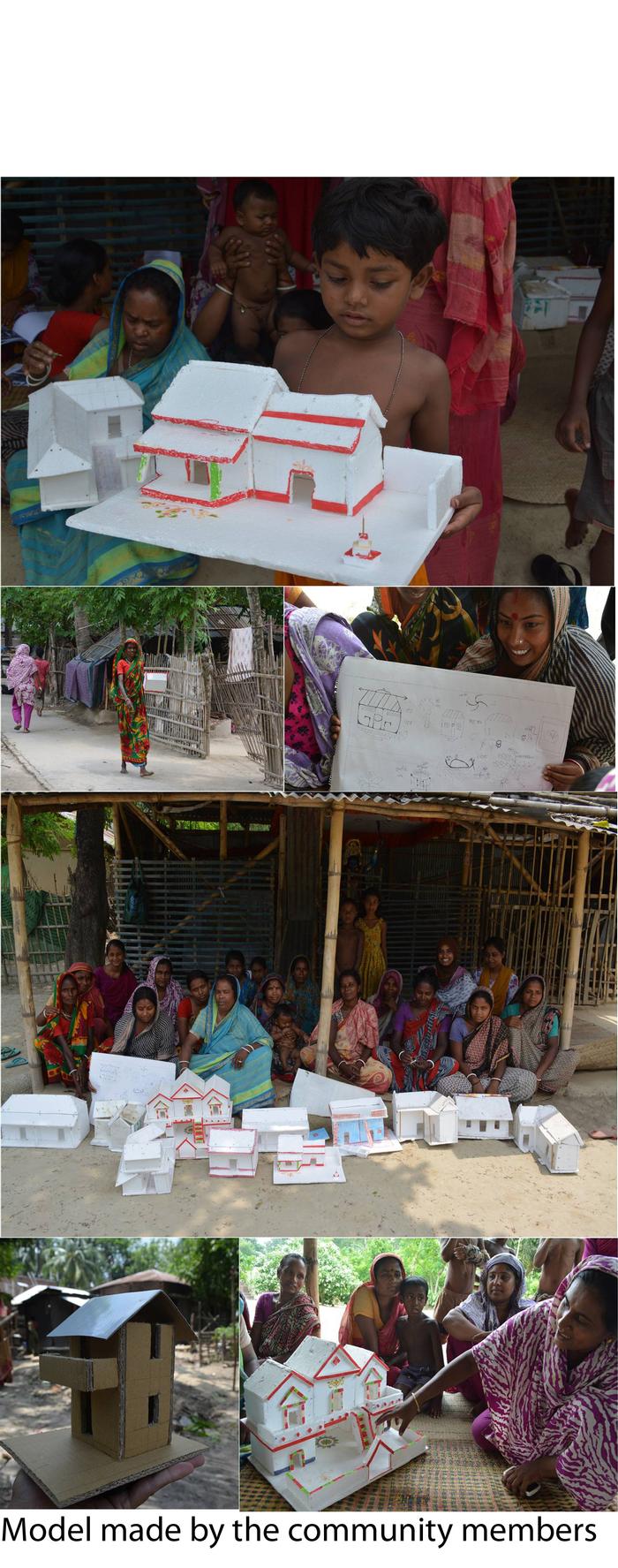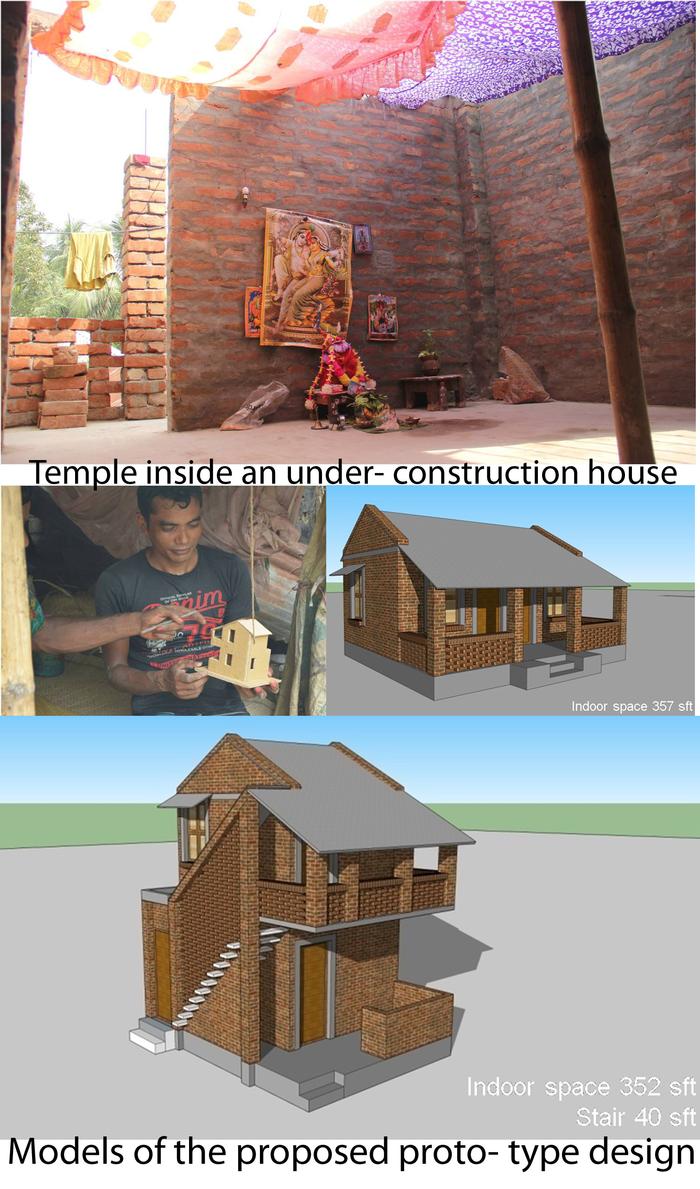[ID:2061] Building Dreams TogetherBangladesh Does making a few houses for the needy solve the housing problem? Every human being has the right to a shelter. But just a shelter does not become a ‘home’. A home has to give you the assurance of security, a sense of ownership and above all, it should be a place one would miss the most if ever he travels far away. It should be able to create a longing and everyone should be proud of their ‘home’.
But the reality in a developing nation like Bangladesh is much more different. Roughly 75% people of the country live on agriculture, and those who migrate to cities for want of a better living- struggle to have a stable life. Many do not have enough to eat properly. In this situation, a place just to pass the night out seems more than they could ask for. Many even do not have that place as well and sleep in the very basket which they use to carry loads during day time. The slums are crowded where the children grow up in unhygienic conditions. But even among these adverse situations, the community bond among people seem to be strong. They seem to have an understanding among themselves. and that’s why they seem to live with a perception of happiness with limited desires. As if being born in poor condition is their only crime for which they suffer a life sentence. But who is to pay attention to them? Who can feel their problems and lend a helping hand? That’s where Architect Hasibul Kabir stepped in.
Architect Hasibul Kabir is a teacher at BRAC University, Bangladesh. He opted for targeting more sensitive issues rather than doing commercial projects like so many others in the capital Dhaka. The thought of the well being of fellow countrymen and economically insolvent people always stirred his mind. And as a result, he tried to think of what he can do from his position to upgrade the conditions of people’s lives.
Among many of the projects undertaken by him, a significant project is discussed here which addresses shelter. The sites are in Jhineidah, situated in the western part of Bangladesh. This place is also special to Ar. Kabir as he is from this region as well. First of all, a few communities were selected in different areas of Jhineidah where there was acute problems of shelter and hygiene.
PREVIOUS CONDITION
The living standard of people of the selected communities located at different parts of Jhineidah was really poor. The households were filthy, unstable and unhygienic. The structures were weak. This was the condition of numerous areas in Jhineidah. But with limited resources, all the places could not be addressed together. So Hasibul Kabir selected a few areas to start the work. But how should he start? Where will the money come from? How to convince the community about what he is going to do? Moreover, will making a few house solve the problems? Will it change their perception about themselves? These questions seemed very important to be answered.
PROCESS
To have a better solution and to change the overall living condition of the whole communities, he charted out a plan. He contacted some local non- government organizations (NGO) to help the process. The Asian Coalition for Community Actions (ACCA) also came forward to help. Then he started discussing the matter with the community people. He proposed to form a co-operative so that every family keeps a small amount of money safe every week. The funds would grow and eventually the houses will be made.
To better understand the system, two members from the community were selected to go to Sri lanka where this type of co- operative system has been successful. Shibani Shardar and Swapan Kumar Shardar along with Ar. Suhailey (Hasibul Kabir's wife) went to Srilanka to understand the scheme. There they observed the dealings of Woman’s bank which is run on similar process. After getting adequate information, they returned. After returning, the two members of the community satisfyingly explained the process to the other members. Here it was evident that it was much easier for a person of the community to communicate with others rather than architects from outside.
Having understood the system, the families began to save money to a selected member of the community. As days went by, the fund began to grow. The fund was made to be revolving so that after the houses were made, the remaining money would go to the next community. A chart is given below showing the savings of different community:
1.Community Name (Mohishakundu Sardar Para Somobai Somitee ) Total Families --------------------------- 25 No. of Families Saving ---------------------23 Weekly Amount of Savings ----------------- 50 BDT (0.62 USD) No of Months Saving ----------------------- 10.5 Total Amount of Savings ------------------- 35000 BDT (437.5 USD )
2. Community Name: (Vennatola Pujamondir Somobai Somitee ) Total Families - -------------------46 No. of Families Saving --------------41 Weekly Amount of Savings ---------- 30 BDT (0.37 USD) No of Months Saving ---------------- 8.5 Total Amount of Savings ------------ 40500 BDT (506.25 USD)
3.Community Name: (Arappur Daspara Somobai Somitee ) Total Families ----------------- 22 No. of Families Saving -----------22 Weekly Amount of Savings ------- 100 BDT (1.25 USD) No of Months Saving ------------- 8.5 Total Amount of Savings --------- 53200 BDT (665 USD)
4.Community Name: (Akota Somobai Somitee ) Total Families ----------------- 12 No. of Families Saving -----------12 Weekly Amount of Savings ------- 50 BDT(0.62 USD No of Months Saving - ------------10.5 Total Amount of Savings --------- 20700 BDT (258.75 USD)
5.Community Name: (Sardar Para Bohumukhi Somobai Somitee ) Total Families ------------------- 21 No. of Families Saving -------------11 Weekly Amount of Savings --------- 50 BDT(0.62 USD) No of Months Saving --------------- 6 Total Amount of Savings ----------- 14000 BDT (175 USD)
Meanwhile, a group was formed by the name POCAA (Platform of community Artisans and Architects) which mainly comprised of volunteer architecture students. They started to draw the community maps. During this process, they thought of engaging the whole community and so they explained how the maps are to be drawn to local school and college students. Then the local children were asked to map out the community. The result was magnificent. The children prepared the map with great details, not even leaving a tree or a shallow water body. The architects were astonished to see the work. The strengths and weakness of the site was easily visible from the prepared map as the poor drainage system was also shown there. This really helped to visualize the extent and condition of the site. They used colored papers to marks the variety of buildings. Eventually, the community map was analyzed and the time for building houses came.
But this brought another question. What should the houses look like? To understand this, Kabir posed another question to himself, ‘whose was the project? Was it his or was it the community’s project?’ the dilemma was solved with another wonderful idea. A model making workshop was taken involving the community people. After that, the families were asked to prepare their dream houses and to bring the models of their dream houses. This produced yet another splendid outcome. The people of the community prepared models of their houses using clay, foam boards, straws and what not. They brought beautifully ornamented models based on the space they were allocated. Some people from the local authority were invited to see the event. They were also impressed and seeing the enthusiasm, the authority also promised to help in any manner they can. This produced a lot of confidence among the people as they feel neglected and have never had the courage to involve anyone from the authority to solve their issues. Anyone who needed to build any house on any premises had to pay a significant amount of money to the authority. Moreover, to get the whole process complete, they had to spend money at different levels. But in this case, the whole community gathered and took the community map which they prepared to the local mayor’s office. They asked for the permission for building. The mayor was taken aback seeing their work. He then waived off all the money that they had to pay and permitted the process. This was a marvelous achievement for the people. Hasibul Kabir always said that the people had no sense of self- empowerment and that's why they did not have courage to confront the authority even when the authority was doing something insensible. So any process that addressed the situation of the whole community should include a way of empowering them as well. This will boost up their courage and a mass psychological development will occur.
Analyzing the models and listening to the desires of the people, the architects and members of POCAA devised two low cost proto type designs for the community. Those who have adequate space will have a single storied house with two rooms and those who do not have enough space will have a double storied house. The designs were really down to the earth with only the essential elements put together. The primary building element was brick. Even then, the people could not believe that this could be their house. But to their own bewilderment, one by one, the houses started to materialize. The community people were the labors by themselves; it impressed even the carpenters who came to work here and they expressed interest to make their own houses similarly.
One by one, every family of the first community got their houses. Their happiness knew no bound. They detailed their home with their own styles and were happy with the result. Next, the next community’s turn came. This time, the people from the first community were asked to play the role of spokes person. The local college students who produced the map of the first community were asked to demonstrate the process to the children of the second community. In this case, it was seen that the communication was much more convenient and easily comprehensible. Due to this, the community map of the second community was also prepared very soon. The other processes were also explained by the people of the first community. This went on and the process continued.
This process was started with five different locations in Jhineidah. The inhabitants of the community are now much more confident and proud of themselves. this brought a great change not only to their living condition but also to their morale. As Shibani Shardar says,’ we never thought we can build houses so easily. Even if we took the money as loan from somewhere, we would spend it in other purposes. Now I have a beautiful home.’
The young people of the first community named the area as ‘Swapno Para’ (Dream community). This process not only solved the housing problem of the people rather it did much more. This instilled the belief among the people that they are also a very important part of the society and they are strong as well. This made them aware of what proper planning can result in and also uplifted their confidence. The local authority also witnessed a different scenario and started to think high of those poor people.
HOW DO I SEE MYSELF IN ASSISTING SHELTER TO THOSE IN NEED:
The place where I reside in is Sylhet which is situated on the eastern part of Bangladesh. Here, the main town is quite well- equipped with necessary facilities but there is a sweeper colony just along the outskirts of the town beside the river Surma. The people of the community live in really poor condition with shaggy and damp households which are very unhygienic and unstable. These pollute the river as well. I intend to work to provide shelter to these people. But the people of the colony are hard to convince. They have a negative impression towards others as they think themselves to be cruelly neglected. Under these circumstances, the process of Hasibul Kabir’s work could be a great way to start building the trust and to engage the people of the colony in understanding their own strengths. The economic condition of the people is very weak which is easily observable by their living condition. This also produces lack of confidence among them and creates a great psychological separation. The children of the community do not find it easy to mix with children of other communities as they feel inferiority-complex. This puts their life into a harsh perspective. But with the river as their backyard and intimate, dense, and cramped households, there can be so many things to be done to upheaval their condition. But just by making new shelters or by fixing their own cramped houses will not significantly bring any change to their condition. For this, a process that engages the whole community and activities in which the whole community can participate spontaneously. Only then will the shelters turn into their ‘home’ and they will have a little bit of honor in their lives.
As Nobel laurite economist Amartya Sen quotes: ‘Poverty is not just the lack of money. It is not having the capability to realize one’s full potential as human being’. Architects do have a great role towards the society. Of course, they can produce great designs and create award winning projects. But to me, the architects who bring a certain change to the psyche of people and instill a feeling of confidence and self- respect among the ‘powerless’ men have a much higher place than others. It is rather easy to win projects, but it is way too much hard to win trust and love of people who have almost no where to go.
Housing projects for the homeless are being undertaken in so many places all over the world as we speak. New houses are being constructed or else temporary shelters are provided. But this will not solve the problem. The solution must contain a holistic approach. First of all, this problem should be addressed with proper parameters and the issues should be brought in front so that they are 'visible'. The solutions must contain not only the skill of the architects and engineers but also the dreams and aspirations of the people. And the implementation process should necessarily involve the participation of the whole community so that a constructive playfulness and a passive sense of ownership can grow. Only then the change will make a deep mark and a major transformation will be possible.
If you would like to contact this author, please send a request to info@berkeleyprize.org. |




